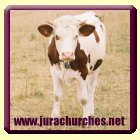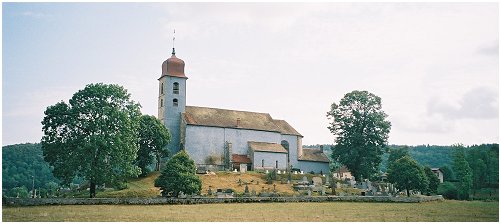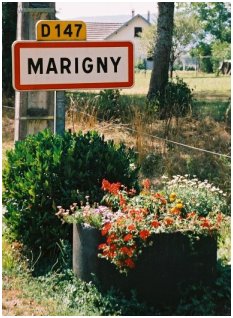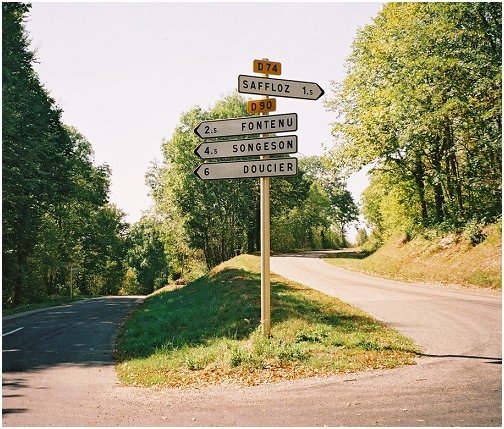 home
e-mail
The
churches:
Baume l'abbaye
Baume l'église
Blye
Champagnole
Charcier
Charezier
Châtelneuf
Chatillon
Chevrotaine
Collondon
Crotenay
Doucier
Fontenu
le Frasnois
Lieffenan
Lons le Saunier
Loulle
Marigny
Menetrux
Monnet-la-Ville
Mont-sur-Monnet
Pont de Poitte
Saffloz
Saint-Sorlin
Songeson
le Vaudioux
Vertamboz
Vevry
Villiard-sur-l'Ain
bibliography
links
maps
www.suffolkchurches.co.uk
www.simonknott.co.uk

|
 |
 |
|
 |
| |
Jura churches
| |
The
Jura is one of the most easterly
départements of France. It sits
on the Swiss border to the north
of Geneva, and is the most
southerly of the four
départements that make up the
région franche-comte. It is a
gentle land of meadows and
forests, set in a landscape that
climbs from below 300m in the
north west to above 1200m in the
south east. It is a rural
département - the area is 5000
square kilometres, and there are
just 230,000 people. (In
comparison, 'rural' Suffolk in
England is less than two thirds
the size, with three times the
population).

Saint-Maurice,
Monnet-la-Ville, on its conical
churchyard near Lac de Chalain
|
|
| |
The
villages of the Jura tend to be
close together; it is hard to
cycle for more than three miles
without coming to another one.
Wide empty roads connect them,
perfect for cycling. The
villages are small, and intensely
agricultural. Shops, cafes and
bars are few and far between
outside the towns and tourist
areas.
For
the English, this is not a
well-known département.
Most
villages are clustered around
their church, and the church is
usually at the highest point in
the village. Many of the churches
have pretty domes, similar in
style to those of neighbouring
Bourgogne; but the Burgundy
churches tend to be set in a
harsher landscape.
|
|
| |
The Jura is
le pays qui respire -
the richness of the land is there
for all to see. The height of the
ground and its distance from the
nearest sea mean that a heavy dew
falls every morning, and the
grass is rich and green even
after months without rain. The
slopes are heavily wooded; you
climb up though forests, and then
cycle out into wide, gently
undulating alpine meadows. There
are harsh winters, and baking
summers.
Because there is so
little traffic away from the main
roads, the Jura has a soundtrack
all of its own. As you cycle
between the villages in the high
heat of the summer, the buzzards
cry out as they spiral above you,
and through the forest come the
cowbells from a distant meadow.
Above all else, the
brown and white cows symbolise
the Jura, lazily grazing their
way across the sloping meadows,
their bells a languid serial
cacophony. Their milk goes to the
village fruitiéres, who turn it
into the famous Comté cheese.
One of the cows is
on the site logo; I met her on
the high lonely road between
Fontenu and Mont-sur-Monnet. I
was having trouble with my
camera, but she stood patiently
waiting for me while I sorted it
out.
|
|

Marigny, in the south of the
Jura
|
|
| |
The
Jura has no towns of any size.
The largest is Dole, up in the
north, which has about 30,000
people. The departmental capital,
Lons-le-Saunier, is near the
centre, and has about 24,000
people. Champagnole has about
8,500. In the countryside, the
tourists tend to congregate
around the lakes of the
south-east. At lower altitudes,
the vines cover southern slopes;
higher up, the forests become
thicker, and the air is full of
the heady scent of pine, gentian
and myrtille. The land becomes
mountainous on the Swiss border. The
churches of the Jura tend to have
few Romanesque or Gothic
survivals. Many were heavily
restored in the 17th century.
They have escaped the worst
excesses of Baroque, and are
generally rural and charming.
|
|
| |

Roads double back on the
slopes of the high Jura
There is an abbey of
national significance at
Baume-les-Messieurs, and a small
cathedral at Saint-Claude.
Significant early medieval
survivals can be found at Dole
and Lons-le-Saunier.
I began documenting
the churches of the Jura in the
summer of 2002. I took most of
the photographs here in the
summer of 2003. So far, 29
churches have been added to this
site - there are links to them in
the left hand column. More will
be added in the years ahead.
In the left hand
column you will also find links
to a map of the area, and a guide
to useful books and websites.
Simon Knott,
Marigny/Ipswich
With
thanks to Daniel Police for his
ever-helpful advice, and to
Jacqueline for her patience.
|
|
|
|
|
 |
|
 |
|
